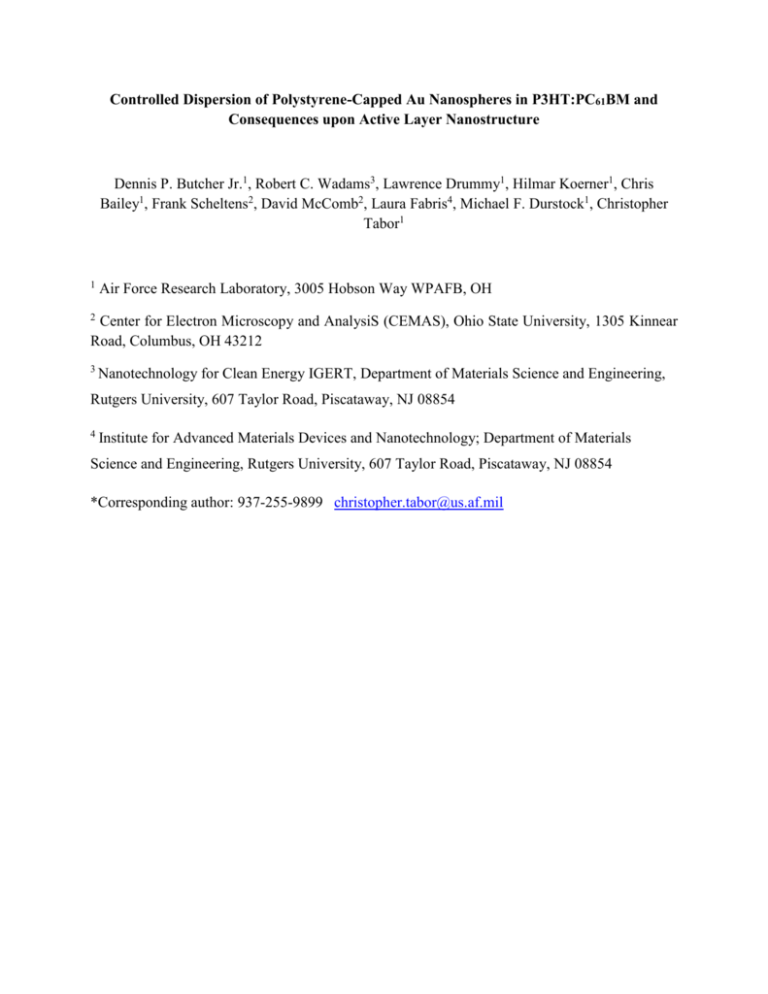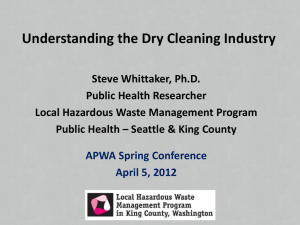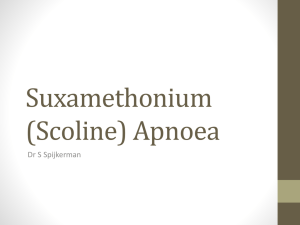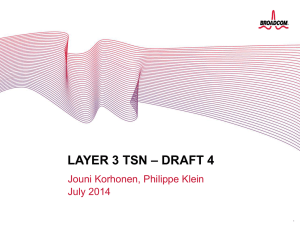polb23962-sup-0001-suppinfo01
advertisement

Controlled Dispersion of Polystyrene-Capped Au Nanospheres in P3HT:PC61BM and
Consequences upon Active Layer Nanostructure
Dennis P. Butcher Jr.1, Robert C. Wadams3, Lawrence Drummy1, Hilmar Koerner1, Chris
Bailey1, Frank Scheltens2, David McComb2, Laura Fabris4, Michael F. Durstock1, Christopher
Tabor1
1
Air Force Research Laboratory, 3005 Hobson Way WPAFB, OH
2
Center for Electron Microscopy and AnalysiS (CEMAS), Ohio State University, 1305 Kinnear
Road, Columbus, OH 43212
3
Nanotechnology for Clean Energy IGERT, Department of Materials Science and Engineering,
Rutgers University, 607 Taylor Road, Piscataway, NJ 08854
4
Institute for Advanced Materials Devices and Nanotechnology; Department of Materials
Science and Engineering, Rutgers University, 607 Taylor Road, Piscataway, NJ 08854
*Corresponding author: 937-255-9899 christopher.tabor@us.af.mil
Supporting Information
Photovoltaic performance study of P3HT:PC61BM films at different Au/PS particle loading
density
Figure 6A plots the power conversion efficiency (PCE) of devices loaded with between 0
wt% (control) and 10.0 wt% Au/PS nanospheres for samples which were dried for >20 minutes
(black line) compared to identically prepared films which were thermally annealed at 110°C for
10 minutes (red line). For the ‘as dried’ devices, PCE increases with Au/PS loading, relative to
the control, between 0.5 wt% and 5.0 wt%, and begins to drop off at very high particle loading
density. The same general trend is observed for devices that have been thermally annealed.
Again, peak performance is achieved by loading at 0.5 wt% to 5.0 wt%, suggesting a loading
threshold beyond which parasitic processes reduce power conversion efficiency; this trend is
consistent with previous literature reports featuring Au nanoparticles as sources of plasmonic
enhancement.{Xu, 2013; Janković, 2013} PCE, however, is significantly higher for ‘as dried’
devices when compared to those which were later thermally annealed.
Changes in the observed PCE upon loading Au/PS nanospheres provide evidence of
electrical changes in the device induced by structural and/or optical changes in the film. Open
circuit voltage (Voc) at each particle loading density, shown in Figure 6B, is constant among the
‘as dried’ devices. Thermally annealed devices that were loaded with Au/PS particles also had a
constant Voc near 0.56 V; the exception to this trend was the thermally annealed control device,
which experienced a dip relative to the others after heat treatment to about 0.535 V. Changes in
short circuit current density (Jsc), as seen in Figure 6C, are small and within the margin of error
upon loading Au/PS nanospheres into the devices at between 0.5 wt% and 5.0 wt%. At very
high Au/PS loading (10 wt%), there is a noticeable drop in current density which correlates with
the drop in PCE for those devices.
Analysis of the J-V curves reveals the primary reason for increased PCE in devices
loaded with Au/PS nanospheres when compared to controls processed under identical conditions
to be higher fill factor (FF), as shown in Figure 6D for both ‘as dried’ (black line) and thermal
annealed (red line) samples. Increases in fill factor of up to 5% for ‘as dried’ samples and up to
9% for thermally annealed samples, relative to their respective controls, are observed. Devices
which are thermally annealed exhibit much lower FF relative to the comparable ‘as dried’
samples. These values are charted in Table S2 along with J sc, Voc and PCE. Both the drop in fill
factor upon thermal treatment for devices loaded with identical amounts of Au/PS, as well as the
higher fill factor with modest Au/PS particle loading (0.5 wt% to 5 wt%), suggests an active
layer morphological origin for most of the observed changes in PCE. In order to probe the
changes in fill factor, fitting of J-V curves (shown in Figure S5) according to the One-Diode
Model is performed to determine how the shunt and series resistances are affected by
incorporation of gold nanoparticles.{Giebink, 2010}
Shunt resistances for ‘as dried’ (black line) and thermal annealed (red line) devices are
shown in Figure 6E and closely track the increases in PCE and fill factor with increasing Au/PS
loading density. Additionally, devices which are thermally annealed exhibit a far lower shunt
resistance than the identically loaded, untreated films. Shunt resistance is a measure of film and
interface quality, with lower resistance indicating leakage pathways that reduce effective
photocurrent from the device.{Wong, 2012} A higher shunt resistance, therefore, corresponds to
reducing or eliminating these defect current pathways within the film and at the interfaces. We
suggest the Au/PS nanosphere clusters provide a mechanism to reduce the amount of charge
trapping film defects and prevent recombination pathways.
HAADF STEM and TEM
tomographic analysis discussed above showed that Au/PS particles segregate from the P3HT and
PC61BM rich domains and form their own PS-rich phase, which in a control film may otherwise
end up as a macroscopic void or mixed phase defect site. These areas are known to act as sites
for charge trapping and recombination, thereby lowering device efficiency.{Wu, 2013
#34;Vohra, 2012 #49} Doping of P3HT:PC61BM films with PMMA or PS eliminates these
voids with the effect of increasing fill factor and shunt resistance, which allows more efficient
charge extraction from the active layer.{Wu, 2013; Vohra, 2012} PMMA doping in the report
by Wu, et. al also led to a reduction in film absorption and thus less short circuit current density
because PMMA replaced absorbing donor material. This effect is not present in our system,
likely because of beneficial optical effects from the Au plasmon resonance. While 15 nm Au/PS
nanospheres do not appear capable of significantly increasing absorption in the P3HT beyond
that seen in the control film, it does have a strong enough influence to compensate for the
relative dilution of the donor P3HT caused by incorporation of Au/PS.
Fluorescence of P3HT:PC61BM films via dark field microscopy
This fluorescence is characterized in the hyperspectral image, collected under 575 nm
excitation with a 610 nm longpass filter, in Figure S8C. The darkened areas match up to the
bright areas in Figure 7B, which are attributed to lower fluorescence cause by displacement of
P3HT by Au/PS clusters. Figure S8F charts the fluorescence spectra of pristine areas of film
(black line) and those areas containing Au/PS clusters (red line). This figure also compares these
areas of fluorescence to the bulk photoluminescence for an identically prepared film.
All
fluorescence peak positions are in close agreement with those reported elsewhere {Xie, 2010;
Piris, 2009} and give high confidence as to their origin from P3HT radiative recombination.
Regardless of any small fluorescence changes between bulk film and areas with Au/PS clusters,
what is apparent is that the bright areas from the hyperspectral images in Figure 8A and 8B do
not originate from locally enhanced fluorescence, as these areas would also show significantly
stronger intensity in Figure S8C. The excitation wavelength and filtering of light below 610 nm
precludes any possibility that the peaks in Figure S8F originate from scattering.
J-V Characterization of BHJ Devices Dried Under Different Conditions
It has been well documented that the environment of the particles as they begin to interact
with one another has a significant effect on their optical and electrical properties. To
demonstrate some of those effects, we fabricated devices using the films with nanoparticles
loaded into them processed under various conditions and tested photovoltaic parameters. Figure
S9 displays J-V curves for devices fabricated under different drying conditions: <1 minute
(black), 10 minutes (blue), and >20 minutes (green). J-V curves are displayed as solid lines for
controls and dashed lines for 2 wt% Au/PS loaded devices. Results are tabulated in Table S2.
The inclusion of Au/PS nanospheres in each case increases device PCE, Jsc, and FF slightly
relative to control devices, though the largest determinant of device performance is the drying
time. Devices dried for 10 minutes or >20 minutes exhibit strong performance (3.2-3.4 % PCE)
while devices dried more quickly show extremely low short circuit current density and only 1.21.4 % PCE. PCE gains of around 5 % are achieved for slow dried devices (>20 minutes), caused
by small increases in Jsc and FF. Thus, further study regarding the impact of film processing and
particle loading is performed on devices which are dried in a controlled environment for >20
minutes.
J-V Resistance Fitting Details
The current-voltage (J-V) response of a photovoltaic (PV) device provides crucial
information regarding its performance. Most typically used are the open circuit voltage (Voc),
the short circuit current density (Jsc), the fill factor (FF), and the power conversion efficiency
(PCE). While these parameters are great metrics, they lack specificity in their connection to the
actual physical properties which generate them, such as electrical resistances and the properties
of the diode junction. To understand these effects, the IV curve must be fit using a physical
model based on the device properties. There are a few different models to fit IV curves, the one
which we use is referred to as the one diode model. The equivalent circuit model for this
equation is shown in Figure S10.
This model has four major components, the photocurrent (IL), the diode with current (ID),
the shunt resistance (Rsh), and the series resistance (Rs). This is the simplest circuit structure that
can describe the basic PV IV curve, and has been accepted for use in crystalline, polycrystalline,
and amorphous inorganic devices as well as organic devices. At first, it seems counterintuitive
that one model can fit so many device architectures with different physical interactions that drive
the PV effect, but it has been shown theoretically to be an appropriate approximation, even for
organic photovoltaics [see Giebink et. al., Phys Rev B, 82, 155305 (2010)] assuming the physics
of charge generation.
By applying Kirchoff’s current law to the above circuit diagram, we obtain the following
equation,
𝐼 = 𝐼𝐷 + 𝐼𝑆𝐻 − 𝐼𝐿
Where ID is the current through the diode, ISH is the current through the shunt resistance, and IL is
the photocurrent. The values of the diode and shunt currents depend on the externally measured
s
= -I*Rs), resulting in a
-I*Rs. From this result, it is easy to derive the
other form of the diode and shunt currents to be,
𝐼𝑆𝐻 =
𝑉 − 𝐼 ∗ 𝑅𝑠
𝑅𝑠ℎ
𝐼𝐷 = 𝐼𝑜 (𝑒
(
𝑉−𝐼∗𝑅𝑠
)
𝑉𝑡
− 1)
where Io is the reverse bias saturation current, and Vt = nkT/q is the thermal voltage which
consists of the ideality factor n, the Boltzmann thermal energy kT, and the charge of the carriers
q. When these components are all combined, the following form of the IV equation is obtained.
𝐼(𝑉) = 𝐼𝑜 (𝑒
(
𝑉−𝐼∗𝑅𝑠
)
𝑉𝑡
− 1) +
𝑉 − 𝐼 ∗ 𝑅𝑠
− 𝐼𝐿
𝑅𝑠ℎ
As one can see, this equation is self-consistent with respect with I, and therefore cannot
be derived analytically. To numerically solve this equation at any given voltage, it is easier to
think of this equation as the intersection of two functions of voltage with a parametric parameter
I (given all fundamental constants were fixed). These two functions, defined as F1 and F2 are
shown below, and an example of their solution at a particular voltage are shown in Figure S11.
𝐹1 (𝑉, 𝐼) = 𝐼 (1 +
𝑅𝑠
𝑉
) + 𝐼𝐿 −
𝑅𝑠ℎ
𝑅𝑠ℎ
𝐹2 (𝑉, 𝐼) = 𝐼𝑜 (𝑒
(
𝑉−𝐼∗𝑅𝑠
)
𝑉𝑡
− 1)
Tables
Table S1: Au/PS nanosphere cluster size distribution within the active layer as derived from
bright field TEM images from Figures 3 and 4.
<1 minute
10 minute
>20 minute
Drying Condition, 2 wt% Au/PS
Cluster Area
Cluster Diameter Cluster Number
(nm2)
(nm)
Density
(clusters/µm2)
8337 ± 5178
103 ± 81
3.8
18563 ± 12196
154 ± 125
1.0
47842 ± 26059
247 ± 182
0.7
0.5 wt%
1.0 wt%
5.0 wt%
10.0 wt%
Particle Loading Density, Standard Processing
Cluster Area
Cluster Diameter Cluster Number
2
(nm )
(nm)
Density
(clusters/µm2)
13212 ± 16042
130 ± 143
0.6
22000 ± 15243
167 ± 139
0.5
37835 ± 38131
219 ± 220
1.0
106086 ± 54816
368 ± 264
0.8
0.5 wt%
1.0 wt%
5.0 wt%
10.0 wt%
Particle Loading Density, Thermal Annealed
Cluster Area
Cluster Diameter Cluster Number
2
(nm )
(nm)
Density
(clusters/µm2)
15308 ± 12794
140 ± 128
1.1
32981 ± 16281
205 ± 144
0.6
86432 ± 52140
332 ± 258
0.7
529920 ± 387039
821 ± 702
0.2
Total Cluster Area
(nm2)
1.49 × 106
9.10 × 105
1.58 × 106
Total Cluster Area
(nm2)
3.44 × 105
5.28 × 105
1.78 × 106
4.14 × 106
Total Cluster Area
(nm2)
8.11 × 105
9.89 × 105
2.68 × 106
4.77 × 106
Table S2: I-V parameters determined from photovoltaic characterization in Figures S3 and S4.
Drying time Samples
Control, <1 min Dry
2 wt% Au/PS, <1 min
dry
Control, 10 min dry
2 wt% Au/PS, 10 min
dry
Control, >20 min dry
2 wt% Au/PS, >20
min dry
Loading Density
Samples, Solvent
Annealed
Control
0.5 wt%
1.0 wt%
5.0 wt%
10.0 wt%
Loading Density
Samples, Solvent plus
Thermal Annealed
Control
0.5 wt%
1.0 wt%
5.0 wt%
10.0 wt%
Jsc
(mA/cm2)
2.96
± 0.43
3.38
± 0.39
9.31
± 0.10
9.47
± 0.12
9.06
± 0.07
9.51
± 0.22
FF
(%)
61.3
± 5.9
64.2
± 1.6
62.5
± 0.1
65.2
± 1.5
63.4
± 0.3
65.1
± 0.8
Voc
(V)
0.649
± 0.008
0.638
± 0.013
0.567
± 0.005
0.543
± 0.012
0.565
± 0.003
0.546
± 0.002
PCE
(%)
1.18
± 0.24
1.38
± 0.17
3.31
± 0.06
3.36
± 0.04
3.24
± 0.02
3.39
± 0.10
Δ PCE
(%)
Jsc
(mA/cm2)
FF
(%)
Voc
(V)
PCE
(%)
Δ PCE
(%)
8.56
± 0.19
8.91
± 0.29
8.69
± 0.22
8.73
± 0.2
8.08
± 0.04
65.4
± 0.6
66.7
± 1.3
68.6
± 1.2
67.0
± 1.1
67.1
± 0.5
0.563
± 0.005
0.554
± 0.004
0.559
± 0.005
0.558
± 0.003
0.557
± 0.002
3.15
± 0.08
3.29
± 0.13
3.33
± 0.09
3.26
± 0.09
3.02
± 0.02
Jsc
(mA/cm2)
FF
(%)
Voc
(V)
PCE
(%)
8.70
± 0.14
8.83
± 0.18
8.71
± 0.13
8.68
± 0.12
8.35
± 0.09
58.2
± 1.0
62.0
± 1.0
62.9
± 1.2
61.1
± 0.9
62.4
± 1.2
0.534
± 0.011
0.561
± 0.007
0.561
± 0.007
0.562
± 0.004
0.553
± 0.009
2.71
± 0.13
3.07
± 0.13
3.08
± 0.11
2.98
± 0.06
2.96
± 0.16
+ 16.9
+ 1.5
+ 4.6
+ 4.4
+ 5.7
+ 3.5
- 4.1
Δ PCE
(%)
+ 13.3
+ 13.7
+ 10.0
+ 9.2
Figures
Figure S1: Photographs of the device architecture and masking scheme. (A) Top of Device,
active area 0.175 cm2, (B) Optical Mask, illumination spot 0.095 cm2, (C) Back of Device, (D)
Back of Device with optical mask in place. Yellow lines indicate the margins of the ITO on the
substrate. Green Circle indicates approximate area of illumination when substrate is masked.
Figure S2: TEM micrographs comparing CB cast devices (A) and DCB cast devices (B) at 2
wt% loading of Au/PS nanospheres.
Figure S3: EDS spectrum imaging of (A) gold, (B) carbon, (C) sulfur, and (D) composite
spectrum.
Figure S4: (A) FIB cross-section view HAADF-STEM of 2 wt% Au/PS nanosphere loaded
DCB-cast BHJ device (from area outside PEDOT:PSS footprint). (B) Cross-sectional view of
TEM tomography reconstruction from Figure 4E and 4F.
Figure S5: J-V plots of devices loaded with 0 wt% (control), 0.5 wt%, 1.0 wt%, 5.0 wt%, and
10.0 wt% Au/PS nanospheres from ‘as dried’ devices (A) and thermal annealed devices (B).
Figure S6: Absorbance spectra derived from integrating sphere measurements for (A) devices
dried for <10 s, 30 s, 10 min, and >20 min (solid – control, dashed – 2 wt% Au/PS nanosphere).
Devices loaded with 0 wt% (control), 0.5 wt%, 1.0 wt%, 5.0 wt%, and 10.0 wt% of Au/PS
nanospheres, and processed by (B) standard drying for >20 min and (C) thermal annealing.
Figure S7: UV-vis absorption of Au/PS nanospheres suspended in toluene (A) and Au/PS
nanospheres dispersed within a CB-cast BHJ film at 2 wt% loading (B).
Figure S8: Hyperspectral fluorescence image obtained for a 5 wt% Au/PS loaded thermal
annealed DCB film using 575 nm excitation wavelength and a 610 nm longpass filter (C). (F)
Fluorescence spectra of pristine film areas compared to areas with Au/PS clusters along with
bulk photoluminescence of P3HT:PC61BM of 5 wt% Au/PS thermal annealed films.
Figure S9: (A) IV plot of control and 2 wt% Au/PS nanosheres loaded devices at <10 s, 30 s, 10
min, and >20 min drying times with (D) power conversion efficiency (PCE) of those devices.
Figure S10: One diode model equivalent circuit model.
1.5
F1(V,I)
F2(V,I)
F1,F2 (mA)
1.0
Solution (I,V)
0.5
0
-0.5
-1.0
-0.5
0
0.50.6715
1.0
Voltage (V)
Figure S11: (Left) An example solution to the IV curve derived from the intersection between F1
and F2. The solution shown is the IV curve solution at (V,I) = (0.6715V,-0.1mA). (Right) The
flow diagram for fitting an experimentally obtained IV data.






